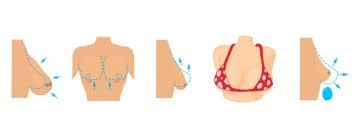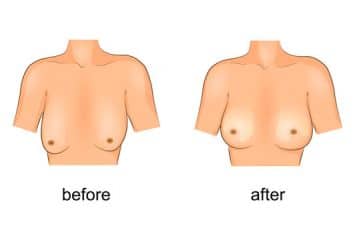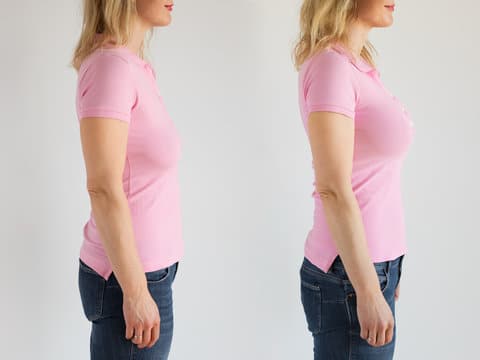Breast enlargement surgery is an invasive procedure. Have you ever thought about alternatives to breast implants?
Breast lift, an alternative to breast implants, is a procedure that lifts and reshapes the breast without necessarily increasing or reducing the size. Breast lift, or mastopexy, is a very common procedure. According to statistics from the American Society of Plastic Surgeons, it is estimated that surgical breast lift procedures have increased by 70% in the last two decades, becoming increasingly more common than other surgical breast treatments such as implants.
What is a breast lift?

A breast lift, also known as mastopexy, is a procedure performed by a plastic surgeon in which excess skin is removed, and breast tissue is reshaped to raise the breasts. It is a procedure that changes the shape of your breast without significantly changing the size. However, a breast lift can also be done in combination with breast augmentation or breast reduction.
Why having a breast lift?
You might choose to have a breast lift for many reasons. For example, if your breasts sag or your nipples point downward due to changes in your breast elasticity and firmness. It is important to remember that breast tissues are supported by ligaments (called Cooper’s ligaments). And that these ligaments will stretch out over time. These changes are completely normal and can be caused by:
- Gravity – this seems like the most obvious one. The most common cause of sagging breasts is simply the passage of time. As time goes by, it’s natural for the original shape of the breasts to lose elasticity and droop because gravity will cause ligaments in the breasts to stretch and sag. The medical term for sagging is breast ptosis and is one of the most common conditions treated by plastic surgeons. Large breasts have a higher chance of sagging just because the higher breast mass is more vulnerable to the gravitational pull.
- Pregnancy – during pregnancy your breast get fuller and heavier, and this cause the ligaments that support them to stretch. This stretch can contribute to sagging breast after pregnancy, whether you breastfeed your baby or not.
- Weight fluctuations. Changes in your weight can cause your breast skin to stretch and lose elasticity.
- Menopause – hormonal changes can affect skin elasticity
- Overexposure to sun – UV rays can break down collagen and elastin, the two proteins responsible for skin’s elasticity
- Smoking – smoking can cause skin to lose its strength and flexibility
Therefore, you might consider a breast lift if:
- Your breasts sag — they've lost shape and volume, or they've gotten flatter and longer
- Your nipples — when your breasts are unsupported — fall below your breast creases
- Your nipples and areolae point downward
- Your areolae have stretched out of proportion to your breasts
- One of your breasts falls lower than the other
Am I good candidate for a breast lift?

As with any cosmetic procedure, it is important not to rush into it the decision. If you have decided that you want to do something about your saggy breast, finding a board-certified surgeon and discuss your options is the first step you should take. A breast lift will boost your self-image and self-confidence, and your surgeon will guide you in the process, explaining every step, discussing expectations, and designing a treatment plan tailored to your aesthetic goals.
To have a breast lift surgery you will need to be of a healthy weight and not smoking. A breast lift can be done of breasts of any size. However, women with smaller sagging breasts are more likely to have longer lasting results. This is because larger breasts are heavier, which makes the ligaments more likely to stretch again. If you want to change the size of your breast, breast reduction or breast augmentation may be a better choice for you. Again, your surgeon will explain to you the options and the alternatives and what you can realistically expect from any of these procedures.
If you are considering a pregnancy in the future, you might want to delay the breast lift procedure because your breasts could stretch during pregnancy, offsetting the results of the lift. Another consideration is breastfeeding. Breastfeeding after a breast lift is usually possible after a breast lift, however, some women might have difficulty producing enough milk.
Is a breast lift safe?
Yes, many research studies have shown that breast lift procedures are safe, with minimal risk of complications and a high degree of patients satisfaction.
The breast lift surgical procedure is performed under a light general anaesthetic administered by a board-certified anaesthesiologist to ensure maximum safety and comfort for the patient.
Your plastic surgeon will advise you on how to prepare for the procedure and the aftercare. A full recovery will take approximately 6-8 weeks, after which you can resume all your previous activities. For any questions or concerns you might have, your surgeon will always be available if you need them.
What to expect from a breast lift procedure
Breast ptosis is a common occurrence following weight loss, pregnancy, and breastfeeding, or just as a result of physiological ageing. These circumstances can lead to a loss of youthful appearance of the breast, with changes in shape, volume, and contour, sometimes accompanied by a change in the position of the nipple and the areola (the dark area around the nipple).
A breast lift procedure raises the breasts by removing excess skin and tightening the surrounding tissue to reshape and support the new breast contour. When a breast lift is performed, the breasts will be repositioned, and the removal of excess skin will cause the breasts to rest higher up on the chest. This will undoubtedly give you a more youthful appearance and more shapely and firmer breasts. While breast implants add more weight, breast lifts can indeed improve overall spinal health, and women often report relief from back pain and poor posture. Most of the patients also report an increase in body confidence following the recovery.

Isreal olabanji a dental assistant and public health professionals and has years of experience in assisting the dentist with all sorts of dental issues.
We regularly post timely and trustworthy medical information and news on Fitness, Dental care, Recipes, Child health, obstetrics, and more.
The content is intended to augment, not replace, information provided by your clinician. It is not intended nor implied to be a substitute for professional medical advice. Reading this information does not create or replace a doctor-patient relationship or consultation. If required, please contact your doctor or other health care provider to assist you to interpret any of this information, or in applying the information to your individual needs.






